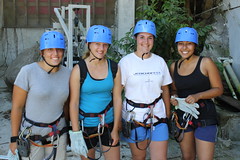The returning Spring 2009 Guatemala Cross-cultural group shared reflections and adventures from their experiences in Central America in chapel on April 20. Listen to it on the EMU Podcast.
Category Archives: Latin America 2009
Coffee
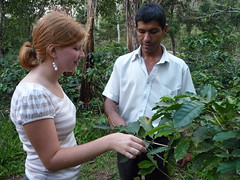 The coffee industry has had a major impact on the lives of most of Central America´s rural communities. In many cases, it has further impoverished families, creating land tenure problems and trapping small growers in a cycle of low selling prices and high production costs. However, some small coffee growers have found that by forming cooperatives, they are able to earn fairer wages for the coffee they produce.
The coffee industry has had a major impact on the lives of most of Central America´s rural communities. In many cases, it has further impoverished families, creating land tenure problems and trapping small growers in a cycle of low selling prices and high production costs. However, some small coffee growers have found that by forming cooperatives, they are able to earn fairer wages for the coffee they produce.
CECOCAFEN is one of these cooperatives, representing 2,637 small coffee growers. Santiago Dolmus, one of CECOCAFEN´s agronomists, referred to the cooperative as a “democratic” business that is tightly linked to the individual producers. Apparently, marketing and finding a fair price for coffee are the biggest struggles for coffee growers. As a large cooperative, CECOCAFEN can find markets for the coffee that Hill bring fairer wages to the farmers.
Dolmus gave four reasons for the existence of the cooperative: to sell coffee, to provide financing to farmers, to provide technical training to farmers, and to provide special programs for the cooperative´s members. In addition to finding fairer prices for its members, CECOCAFEN runs a women´s microfinancing program, a program to develop a market for high-quality coffee in Nicaragua, a tourism program in rural communities, and a youth education program.
On April 1, we visited Martin Vicente Padilla´s farm near Matagalpa, Nicaragua. Padilla is a member of the CECOCAFEN coffee cooperative and serves on the board of directors. His own coffee finca consists of about 9 acres of land that he tends using only organic farming methods. While organic coffee is his main source of income, he also grows a wide variety of fruits, precious woods, medicinal plants, and staple crops such as corn and beans. He raises chickens for eggs and meat, pigs for meat and extra income, and a cow to provide milk for his family.
While every member of the family works on the finca, they all take education very seriously. Through CECOCAFEN´s youth education program they were able to complete high school. Padilla is determined that all of his children will become professionals in some field of study, and two of them are well on their way, one studying to be a lawyer and another currently studying medicine in Venezuela.
Visiting the Padilla family´s finca reminded me again of how little I know about the origins of common products, in this case, coffee. Our visit also made me rethink my attitude toward coffee drinking. I don´t drink coffee, so I had always thought of it as a waste of resources, kind of like candy that doesn´t exactly hurt one´s body, but doesn´t really do any good, either. I never realized how many hundreds of thousands of people depend on the coffee industry to provide their daily rice and beans. Our visit also drove home the importance of buying fairly traded products. Before this trip, I viewed fair-trade products as things that were great to buy, as long as they were convinient to find and not too expensive. Now I realize that there´s a reason that most commercial coffee is cheaper: the small growers are paying the difference through low wages.
– Christina Harman
Free travel reports
Group: Peyton Erb, Cassie Leatherman, Rebecca Copeland, Yvonne Stauffer
I think we are all equally exhausted tonight. We went on a white water rafting trip today in the Pico Bonito forest just outside of La Ceiba, Honduras. First our guide had all of us stand together and say a prayer before our trip. Then they gave us tips on how to stay afloat if we were to fall off the raft. For three of us, it was the first time rafting. The guide told us all to jump off this 10-foot high rock into these swirling rapids. This was supposed to get rid of our fear of water and learn how to float. We just decided that the guide knew what he was doing and to trust him. We all jumped off one at a time. After many different feats like this one we got on the raft and started down the river. All of this lasted about 3 hours. We then rode back to La Ceiba in a big, green, army looking truck.
-Yvonne Stauffer
 “LAS BANANITAS” (Hannah Kraybill, Monika Burkholder, Jenny Blosser and Charity Strayer)
“LAS BANANITAS” (Hannah Kraybill, Monika Burkholder, Jenny Blosser and Charity Strayer)
It’s called Free Travel, and travel free we did. In eight days, Jenny, Monika, Charity and I passed through three countries, wheeled and dealed in four different currencies, pushed, shoved and bartered our way into ten buses, seven taxies, four boats, two kayaks and rested our weary bodies in five different hotel beds.
From La Ceiba, Honduras, to the Rio Dulce in Guatemala and finally down to Managua, Nicaragua to reunite with out Cross Cultural “family,” whirlwind adventure may sound like a more accurate description. But, in the midst of sun baked bus rides, shady characters, a few seedy hotels, various creepy crawlies, miscommunication, misdirection and misunderstanding, each night as we gathered for our “debriefing,” although physically exhausted, we felt spiritually energized by the adventures of our day.
Whether it was white water rafting, zip lining, a spontaneous conversation with a stranger or fellow traveler, a peaceful kayak trip, a chance encounter with a previous acquaintance, simple yet delicious food, fishing without a rod or late night talks, we molded our week, moment by moment into a priceless life lesson. Starting with flexibility, good humor and a few grin-and-bear-it moments, the result is a week abundant in laughter, beauty of all varieties and a good dose of high quality adventure.
-Hannah Kraybill
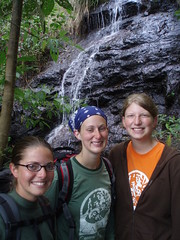 The Unsniffible (Hitch) Hikers
The Unsniffible (Hitch) Hikers
Ingrid Johnson, Allison Glick, Elisa Troyer, and Christina Harman
Our group name comes from our stench after hours of hiking and riding over dusty bumpy roads in the back of a pickup truck. We ended our first day of free travel with a starlight hitch-hike ride on the way to a little town called Gracias, in the mountains of western Honduras. We spent three days and two long nights hiking and camping in Celaque National Park, home to a very lovely cloud forest. We actually hiked for a total of about 13 hours, five of which resulted from a wrong turn on the infamous Sendero El Gallo. Looking back, we are glad for our mistake, as it allowed us to see a wider variety of flora and fauna.
After a good night’s rest in Gracias after we got back from our hiking adventure, we continued in the back of a truck to a little town called La Esperanza where we caught a bus to Tegucigalpa. We spent one night there in a pretty shady part of town after discovering that the two hostels that we had considered were either full or closed. The next day, we continued to the Honduran-Nicaraguan border, where we lost about $40 each to bad exchange rates and crooked taxi drivers. We spent that night at a hostel in Leon, and explored the city the following day, contributing to the local economy through our licuado (milkshake/smoothie drink) consumption. We stayed there for one more night, and the next morning took a bus to Managua, the capital of Nicaragua where we met up with the rest of the group in the lovely Quinta Shalom Guesthouse.
We had a lot of fun and met many interesting and very helpful people along the way. According to Ann, after this experience, we can now travel anywhere in the world!
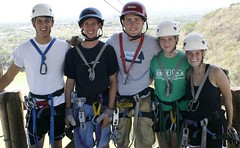 Group: Giles Eanes, Andrew Derstine, Lindsey Grosh, Amy Histand, & Aaron Yutzy
Group: Giles Eanes, Andrew Derstine, Lindsey Grosh, Amy Histand, & Aaron Yutzy
While traveling, sometimes the most random encounters, the ones that you don’t and can’t plan, end up being the most interesting bits of the journey. Our group crossed paths with a colorful host of characters throughout our travels from the Honduran island of Utila to La Ceiba, to Tegucigalpa, and finally to Managua, Nicaragua. If having uncannily good timing with buses is a sign of sharp traveling instincts, I also believe that being available and open to the people along the road, among the pigeons in the park, and in the bus seat next to you, is a mark of traveling well.
We had one such encounter during an afternoon exploration of Utila. We followed some sign for bike rentals off the street and into someone’s yard, because on Utila you’re always walking into someone’s yard to inquire about food or a place to stay or laundry service, and rented mountain bikes that had seen better days. I had to go back to the shed twice for new bikes, as the first two did not successfully make it more than a hundred meters down the road. Third time was indeed the charm, and I managed to coax the geezer of a bike down the rather uncomfortable road to Pumpkin Hill, the formerly active volcano of Utila.
While the five of us rested at the side of the road, an elderly couple crossed our path. In his thick island lilt, the gentleman told us that it was no good, that we were too young to be tired. We proceeded to talk with him about his thirty-five years on the seas as a boat hand, which included docking in Norfolk, VA many times. And then we continued on our way and they on theirs, hauling sacks of wood shavings to their farm. It felt exactly like the sort of encounter one should have on a little island. We went on our way; the bikes survived the trip back to their shed; nothing earth shattering had happened. But the chance encounters we had during the week enriched our experience and added dimension to our journey.
-Amy Histand
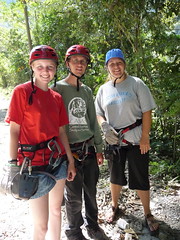 The Meanderers: Jenae Leatherman, Anna Rodgers, Michael Showalter
The Meanderers: Jenae Leatherman, Anna Rodgers, Michael Showalter
The River
Shadowed by the mountain,
Cutting through the trees.
The river roars its victory chant,
Beneath the water, life is gone.
The rain feeds its constant thirst,
The sand plows a deeper tract.
Rocks worn smooth by the river’s wrath,
Cast into shadow by the setting sun.
Whirlpools dance, spinning away,
Ripples pass, a fleeting glance.
Solid yet moving stone,
Liquid in a set path.
The river never rests,
The river always wins.
–Kiwi
As we reflected on our week, our overall trip reminded us of white water rafting the first day on Rio Cangrejal. Even though we knew our final destination and the approximate path we would take, there were always times where plans changed. There were decisions and obstacles that we encountered along the way that were unexpected, but by working together as a group we accomplished what we set out to do and had a fun, interesting experience along the way.
Mining in Honduras
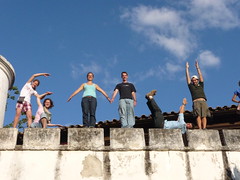 Our visit to ASONOG in Santa Rosa de Copan was very fascinating. I thought that it was very cool that we could make that connection from our speaker in the first week of orientation, Francisco Machado, to the organization that he worked with in Honduras and actually see the work they’re doing that is so dangerous to some people’s interests that he had to flee to the United States. I was appalled to hear of the pollution being produced by the mining companies, especially the cyanide pollution. Cyanide is an extremely deadly poison that they use to extract gold from the rock they mine. After the process is over they either leave the soil, but the cyanide makes is unusable, or they dump it into rivers that serve as water sources for nearby communities. It kind of upsets me. Aren’t there safer ways to extract gold than exposing so many people to such a poisonous substance? Have they no regard for human life at all? I was very glad to hear about the Civic Alliance for Democracy, a civilian organization researching the effects of cyanide on the local health and organizing local communities in protests. The Catholic Church has also gotten involved in ensuring the welfare of its people.
Our visit to ASONOG in Santa Rosa de Copan was very fascinating. I thought that it was very cool that we could make that connection from our speaker in the first week of orientation, Francisco Machado, to the organization that he worked with in Honduras and actually see the work they’re doing that is so dangerous to some people’s interests that he had to flee to the United States. I was appalled to hear of the pollution being produced by the mining companies, especially the cyanide pollution. Cyanide is an extremely deadly poison that they use to extract gold from the rock they mine. After the process is over they either leave the soil, but the cyanide makes is unusable, or they dump it into rivers that serve as water sources for nearby communities. It kind of upsets me. Aren’t there safer ways to extract gold than exposing so many people to such a poisonous substance? Have they no regard for human life at all? I was very glad to hear about the Civic Alliance for Democracy, a civilian organization researching the effects of cyanide on the local health and organizing local communities in protests. The Catholic Church has also gotten involved in ensuring the welfare of its people.
The original mining law that allowed mining companies to evict people from their homes (the new law isn’t much better) reminded me of how in the States, the road building companies used to be able to forcefully take over people’s land to build roads and expand the infrastructure. I’m not really sure how much that goes on anymore, but I’m sure whatever does happen is much different from the new mining law in which there is so much pressure to sell that you’re almost basically forced to.
Along with their work in mining, ASONOG is doing some work with community development, such as risk management and capacity building, which I was very impressed with. They even have regional boards, and they have national conferences to discuss current issues regularly. I was thinking a bit about how these municipalities only receive around 1% profit from the industry that is destroying their land and the health of the people, and it reminded me of discussions we’ve had in class about this idea of center and peripheral countries. The peripheral countries produce raw materials like food and metals, and these are sold to the center countries at a pretty cheap price. These are then processed into refined goods, and sold back to the peripheral countries for a profit. Because the peripheral countries do not provide their own refined goods, and what they can produce is of less monetary value, this creates a great inequality in the wealth of nations. Yes, it’s wonderful that Honduras can produce this raw precious metal, but when it is only sold, or extracted by the center countries, the peripheral countries are taken advantage of, and this is a prime example. The municipalities receive 1% of the profit from the industry that is polluting their soil and drinking water, displacing hundreds of people from their homes, and stripping their land of the natural resources that belong to the people. The Honduran needs to seriously reconsider the concessions it gives to these mining companies. One has to wonder if these communities would actually make more money extracting, working, and selling the gold themselves as artisans.
-Ingrid Johnson
Community service reports
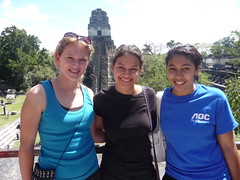 Friday, Feb. 27 was the end of language school. That day we had a Clausura in which each Spanish class did a presentation highlighting their progress from the past 8 weeks. There were a variety of presentations, all showing tremendous improvement in the students’ capabilities. That same afternoon we boarded a small plane for Flores, an island in Lake Petén Itza and stayed the night in a small hotel on the shore of the lake. Saturday morning we traveled to Tikal and enjoyed a tour and significant free time to explore the ancient pyramids in the jungle.
Friday, Feb. 27 was the end of language school. That day we had a Clausura in which each Spanish class did a presentation highlighting their progress from the past 8 weeks. There were a variety of presentations, all showing tremendous improvement in the students’ capabilities. That same afternoon we boarded a small plane for Flores, an island in Lake Petén Itza and stayed the night in a small hotel on the shore of the lake. Saturday morning we traveled to Tikal and enjoyed a tour and significant free time to explore the ancient pyramids in the jungle.
Sunday the group split up. Jared and Addie Leaman, Peyton Erb, Yvonne Stauffer, and Rachel and Ann Hershberger returned to Guatemala City. Jared and Addie were heading back to the States on Monday and the other 4 were headed to San Marcos, Guatemala, bordering Mexico for their week of community learning. The rest of us 18 students and Jim took a boat ride on the lake to visit a zoo and some water slides in the morning before heading to Semesche in Alta Vera Paz province for our community learning.
The group in San Marcos spent their week visiting a number of MCC projects there in a food security program as part of the local catholic dioceses. They were working with MCCer, Nate Howard and his local partners, Juan Pablo and Osmar. They visited two different villages, at altitudes between 8 and 9,000 feet! The first community was Nuevas Maravillas where they attended a meeting to discuss the mushroom project the community is starting. They also have flower projects. These are an attempt to increase income and food supply for the people to avoid the necessity to migrate. The produce from their projects is sold in Mexico, several KMs away.
 The next morning the group was in the school interacting with the children and Peyton was able to teach the preschool class for an hour while the teacher was not there! That same day they caught a bus back to the central town, Sibinal. There they were able to walk around the market in the morning and attend a meeting of the project treasurers from 4 communities. The second village they visited was La Vega, a community working with trout farming projects. The group attended more meetings and was able to relax by playing some soccer with the locals. After another cold night sleeping on hard boards, they woke up Friday to ice on the ground. Friday was the day of a large community celebration as well as the inauguration of about 25 houses in 5 communities built after Hurricane Stan. The group was able to share in these exciting community events and projects and learn more about what MCC and the local communities are doing in the region of San Marcos.
The next morning the group was in the school interacting with the children and Peyton was able to teach the preschool class for an hour while the teacher was not there! That same day they caught a bus back to the central town, Sibinal. There they were able to walk around the market in the morning and attend a meeting of the project treasurers from 4 communities. The second village they visited was La Vega, a community working with trout farming projects. The group attended more meetings and was able to relax by playing some soccer with the locals. After another cold night sleeping on hard boards, they woke up Friday to ice on the ground. Friday was the day of a large community celebration as well as the inauguration of about 25 houses in 5 communities built after Hurricane Stan. The group was able to share in these exciting community events and projects and learn more about what MCC and the local communities are doing in the region of San Marcos.
-Lindsey Grosh
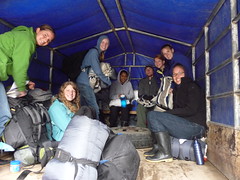 This past week in Alta Vera Paz was one of joys, struggles, and most of all growth for me. We first traveled to Semesche by cattle truck on Monday. That was interesting because it was raining and I´m not sure you could call the path we drove on a ¨road¨ at least in comparison to what we´re used to back in the states. So there was lots of jerking and bouncing, kind of like a country rollercoaster. Then we finally arrived and were welcomed with warm smiles, giggles, and stares from the community. We were divided up into our families and left to settle.
This past week in Alta Vera Paz was one of joys, struggles, and most of all growth for me. We first traveled to Semesche by cattle truck on Monday. That was interesting because it was raining and I´m not sure you could call the path we drove on a ¨road¨ at least in comparison to what we´re used to back in the states. So there was lots of jerking and bouncing, kind of like a country rollercoaster. Then we finally arrived and were welcomed with warm smiles, giggles, and stares from the community. We were divided up into our families and left to settle.
The first half of our week was spent living with our host families and enjoying communication that consisted of ¨oos¨ (good), ¨bantiox¨(thank you) and of course lots of smiles when we didn´t understand. During the day we also spent time planting trees at different houses in order to help the people of this community gain rights to their land. It was very rewarding to be filling  bags with dirt while wearing 24 feet of fabric around my waist, strung up by a string into the native dress they wear called a corte. We often walked home with dirty hands and nails waiting for the fire to start up in the evening for warmth. Those moments around the fire were some of the most meaningful to me because it was there that I felt the overwhelming feeling of being welcomed into my host family. Although it was present throughout the community, it was here that I saw the beautiful spirit of these people.
bags with dirt while wearing 24 feet of fabric around my waist, strung up by a string into the native dress they wear called a corte. We often walked home with dirty hands and nails waiting for the fire to start up in the evening for warmth. Those moments around the fire were some of the most meaningful to me because it was there that I felt the overwhelming feeling of being welcomed into my host family. Although it was present throughout the community, it was here that I saw the beautiful spirit of these people.
On Thursday we set out for a three hour hike to our second community, Sesalche. I don´t know that I have ever had to push myself so hard before. Some of our paths seemed to go up forever and there were certainly times when I wanted just stop. But when we would arrive at the top to see the view,  it was more than worth it. I have never seen anything like it. The endless mountains with the clouds draped across them… I felt like this was God´s way of giving me encouragement to keep going, and after some time we finally arrived.
it was more than worth it. I have never seen anything like it. The endless mountains with the clouds draped across them… I felt like this was God´s way of giving me encouragement to keep going, and after some time we finally arrived.
Once we had finished our first meal at Sesalche, we all headed to the church that was to be our home for the next couple nights. We immediately began pushing the benches together to create our beds and then headed off to the school for an art camp with the kids. Again this was a fun experience because most of us only knew about two words to use to communicate with the kids, but we found that we could learn a lot of new words just by drawing pictures and then pointing as the kids told us the names in K´kchi, their native language. After the art camp we discovered that the kids were not going to let us just walk back to the church. They wanted to play. So we spent the next bit of time playing ¨you´re it!¨ in K´kchi.
The next couple of days were probably some of our hardest. I felt pretty drained from the hike, lack of sleep due to hard wooden boards for beds, and I stopped eating a lot because I wasn´t feeling very good. But despite some of these conditions that we were all experiencing, we were still able to help some of the families with building cages for rabbits and also composting bens. These were a part of the Heffer Project that had been taking place in different communities. In this project families are given different things like animals with the notion that when their animals reproduce, they will then pass the gift on to five more families, and those families to others until everyone that wants to participate is included. It´s a really neat concept and helps the people of these communities take ownership of these movements rather than it being an outsider´s project. So I think we all appreciated being a part of that.
On Saturday we set out  for our three hour hike back to Semesche and even planted some trees on the way when we stopped for lunch. When we returned, we were glad to be able to sit and rest for a little bit, even if it was wooden benches that we were sitting on.
for our three hour hike back to Semesche and even planted some trees on the way when we stopped for lunch. When we returned, we were glad to be able to sit and rest for a little bit, even if it was wooden benches that we were sitting on.
The next morning we all went up to the church to attend a wedding that we were invited to. It was definitely a time to see cultural differences. For one, within this culture the men and women are separate which meant that the bride and groom did not know each other before the wedding. This probably would explain why we did not see them smile at each other. The wedding was also the church service and a baby dedication all in one. So we were there for about three hours. But it was definitely a gift to be able to be a part of this sacred tradition, and another example of how welcoming this community was to invite us to this event. After the ceremony we gathered our things and got back on the cattle truck to start our bumpy journey back to Guatemala City.
As I said before, this week of service was one of great growth for me. I got to experience a way of life that was very foreign to me. I was able to learn some new words and repeat some others more times than I would like…Bantiox. I even arrived at a point where Spanish had the comfort of a native language to me! Though it was hard and possibly the farthest from my comfort zone I have ever been, it was an experience that I, and I´m sure the rest of our group would agree, would not change for the world.
-Rebecca Copeland
Immigration Focus
 A normal field trip brought out strong reactions from our group in our visit to CAM, Centro Atención al Migrante. Our host, Carlos gave us information about their immigrant halfway house and why it is needed. Then this led him to directly state how the U.S. has played a role in causing migration. I have been aware and am still learning just how much the U.S. has interfered in the development of Central America, but it was still a depressing lecture for me. No one really likes to hear how inconsiderate his or her country is. Carlos also abruptly began to ask us questions on how we can make such contradictions like claim to be the freedom light of the world and go fight a war in Iraq or refuse to sign the Universal Declaration of Human Rights.
A normal field trip brought out strong reactions from our group in our visit to CAM, Centro Atención al Migrante. Our host, Carlos gave us information about their immigrant halfway house and why it is needed. Then this led him to directly state how the U.S. has played a role in causing migration. I have been aware and am still learning just how much the U.S. has interfered in the development of Central America, but it was still a depressing lecture for me. No one really likes to hear how inconsiderate his or her country is. Carlos also abruptly began to ask us questions on how we can make such contradictions like claim to be the freedom light of the world and go fight a war in Iraq or refuse to sign the Universal Declaration of Human Rights.
Because of the setting, set up for a speech and spread out, none of us were sure if these were rhetorical questions or not. As comments did spurt out, I noticed how people seemed to have reached a point of not being able to be silent longer. Afterwards students were buzzing with anger. One said it was the first time she felt discriminated for being an American; another was angry that Carlos thought he could just keep accusing us like that. Personally, I came away more depressed than angry, like a beaten dog with its tail between the legs.
As our week focused on immigration ended, I was reminded of how glad I am to have taken a Spanish class at EMU last spring; I hadn’t even known what the class was about when I signed up, but I came out of that class with the beginnings (or more) of understanding of the complexity of immigration, especially in the U.S. Now that I’m in Guatemala, this background helps me see multiple sides when reading the case studies and visiting the U.S. Embassy. I see neither undocumented or legal immigrants, nor the Mexican government or U.S. border patrols as the “evil” ones. I do not, then, have a proposed solution; in fact, the more I know, the more impossible it seems to find a happy, just situation for everyone. But I see places that demand improvement regardless.
-Allison Glick
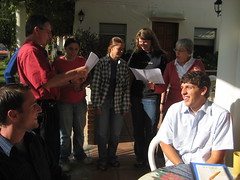 It is amazing how people can touch the lives of others. Today I went walking hoping to find a Mennonite church, Casa Horeb. Andrew’s host mom had told me where the church was as we were driving down the Periferico but I conveniently forgot which avenue she told me. I ended up walking six blocks too far because I thought I was supposed to go to 13th Avenue rather than 19th Avenue. But I am glad that I did. On 13th Ave. I asked a woman if she knew the Mennonite church. Of course she did not even know what a Mennonite is. She told me there were two churches on 13th Ave, but if I wanted to, I could go with them to an Evangelical church. It meant a lot that they invited me to their church, so I went and I really enjoyed my time with them. Their Evangelical style of worship is certainly not my style of Mennonite, but I enjoyed the energy. The lady’s daughter was a huge help during the service and she tried to help me understand what was happening by whispering things in my ear… in Spanish. She is about five but I think she really understood my situation. Later in the service her mom bought some gum to share.
It is amazing how people can touch the lives of others. Today I went walking hoping to find a Mennonite church, Casa Horeb. Andrew’s host mom had told me where the church was as we were driving down the Periferico but I conveniently forgot which avenue she told me. I ended up walking six blocks too far because I thought I was supposed to go to 13th Avenue rather than 19th Avenue. But I am glad that I did. On 13th Ave. I asked a woman if she knew the Mennonite church. Of course she did not even know what a Mennonite is. She told me there were two churches on 13th Ave, but if I wanted to, I could go with them to an Evangelical church. It meant a lot that they invited me to their church, so I went and I really enjoyed my time with them. Their Evangelical style of worship is certainly not my style of Mennonite, but I enjoyed the energy. The lady’s daughter was a huge help during the service and she tried to help me understand what was happening by whispering things in my ear… in Spanish. She is about five but I think she really understood my situation. Later in the service her mom bought some gum to share.
After the loud and disorganized service my new friends and I walked back to the corner where we met. It was nice to have the walking time to chit-chat and the five year old held my hand on the way back. I have not been around children much, since my host parents here in Guatemala are older and do not have children in the house. On our walk I found out that the lady is twenty-five years old, divorced, has two children, and her job is part time. I think she lives with two other ladies and their two children. The gist of this lady’s current situation really put into aspect how much wealth and security is in my life. I saw God through this lady and her family. This put a completely new face on poor people in my life. They are no longer the aggravating beggar, nor the drug addict, of possible thief, but rather my friend and my family. I never want to forget how my life has been touched this week.
-Aaron Yutzy
“There’s so much to think about…”
So I’ve been thinking about the whole idea of Syncretism, Catholic vs. Evangelical, and the ongoing process of change within the Church here, as Rafael was talking to us about yesterday. I’m kind of struggling with it all. Is all syncretism bad? Is my belief a result of syncretism? It doesn’t seem like it, because the Anabaptists back in the day broke away from the Catholic norm, not conformed to it. But then, throw in culture and who knows what, and it seems like everything in this world is syncretism, even me. Everything except for Jesus Christ. He was pure and spotless. Maybe that’s what it means… in this world but not of it. He wasn’t synchronized to anything else. Hm.
And then there’s the whole Catholic-Evangelical battle that’s been going on, really since the 1870’s or earlier. Was that a good divide? It has created such competition and rejection among churches, but yet it allowed for a growth of faith, a mission-oriented stance, and more separation of the (Catholic) Church and State. Do I totally reject the stance of the Catholic Church and their dual focus on Jesus and Mary? Or do I take communion with them? In Italy, any sign of the cross meant being part of the Catholic Church, and any time there was a Catholic parade or activity, all the Evangelicals stayed inside. Within the matter of a week or two, 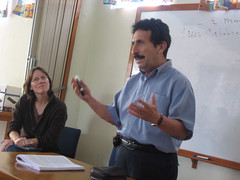 I moved in with a Catholic family, attended a Catholic Peace March, and took communion in a Catholic church. I am torn about what I should accept, what I should take a stance on, and then, there’s Rafael’s questions yesterday…
I moved in with a Catholic family, attended a Catholic Peace March, and took communion in a Catholic church. I am torn about what I should accept, what I should take a stance on, and then, there’s Rafael’s questions yesterday…
What is the reign of God? How closed is too closed to allow the reign of God?
There’s so much to think about, but I am excited to keep learning and asking questions.
Climbing the Fuego Volcano
 Rolling through Antigua this weekend was quite amazing. Even though the country of Guatemala is roughly the size of Ohio, it contains over 30 volcanoes, which are enormous. When I actually (more or less) reached the top of Fuego, I realized how drastic the country really is, in terms of geography. You drive from the busy, huge, smelly, metropolis of Guatemala City, hike a few hours up a mountain, and it seems as though you are in a completely different world.
Rolling through Antigua this weekend was quite amazing. Even though the country of Guatemala is roughly the size of Ohio, it contains over 30 volcanoes, which are enormous. When I actually (more or less) reached the top of Fuego, I realized how drastic the country really is, in terms of geography. You drive from the busy, huge, smelly, metropolis of Guatemala City, hike a few hours up a mountain, and it seems as though you are in a completely different world.
We were drenched and sweating as we hiked 5-6 hours up to the base camp (from 4,500 ft to 10,000 ft), surrounded by jungle trees. But up on top, another 1 ½ hrs and 2,300 ft later, it was windy, and freezing, completely barren.  There was nothing growing. All I could see was rocks. However, looking out across the landscape, I was met with a wonderful sight. Colossal volcanoes, covered in clouds, towering over the rest of the valley. I have never seen anything as awesome. And that is only one small fraction of the country. There are dozens more volcanoes, mountains and ridges that cover the countryside.
There was nothing growing. All I could see was rocks. However, looking out across the landscape, I was met with a wonderful sight. Colossal volcanoes, covered in clouds, towering over the rest of the valley. I have never seen anything as awesome. And that is only one small fraction of the country. There are dozens more volcanoes, mountains and ridges that cover the countryside.
If we compare this country to the United States, we have similar geography, with the same mountains, forests, and beaches. However, our country is 100 times the size, maybe larger. It’s amazing that so little a country can contain so much. This weekend taught me a lot about perception as well. The volcano, from distance, looked like a piece of cake to climb, but it challenged my limits as I struggled all the way to the top. Even from our campsite, the top seemed a short hop away, but boy was I wrong.
Mayan Culture
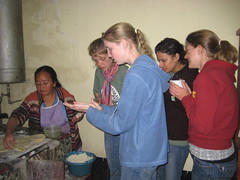 I think you can learn a lot about a group of people by the way they dress and by what food they eat. This occurred to me as I read about the Mayan people. It was very interesting to read about their farming and cornfields. “If there are no tortillas served, you have not eaten a meal.” I thought that showed just how much they use tortillas. It was pretty amazing to read about how many things they make from corn and that everyone grows it. Even though the dollar output would be better if they grew vegetables, they produce corn because it is a reliable source of nutrition. Also, a cornfield is not just made up of corn, the list kept growing of things grown in a cornfield.
I think you can learn a lot about a group of people by the way they dress and by what food they eat. This occurred to me as I read about the Mayan people. It was very interesting to read about their farming and cornfields. “If there are no tortillas served, you have not eaten a meal.” I thought that showed just how much they use tortillas. It was pretty amazing to read about how many things they make from corn and that everyone grows it. Even though the dollar output would be better if they grew vegetables, they produce corn because it is a reliable source of nutrition. Also, a cornfield is not just made up of corn, the list kept growing of things grown in a cornfield.
At the museum we visited last week it was really neat to see the progression of the Mayan’s clothing. Those people are really good at making clothes and finding plants to dye the fabric. I think it is good that they didn’t conform too much to the Spanish in terms of clothing. They really value their history and traditions. I think it is important to realize where each of us came from and have something to remember that by. In the reader it said how the Mayans 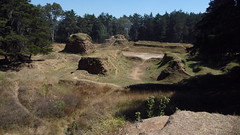 dress to set themselves apart from the rest of Guatemala. Although we do not dress like our ancestors, I’m glad to see that people cherish their history.
dress to set themselves apart from the rest of Guatemala. Although we do not dress like our ancestors, I’m glad to see that people cherish their history.
The writing on the historical sources of Catholic power also intrigued me. In the 1800’s here the church used to hand out mortgages and collect the interest on them. Being a business major I’m trying to keep in touch with the current issues. In the current economic crisis you hear all these different companies being affected, but I have not heard the church’s name in the midst of Fannie Mae and Freddie Mac. It just seems very odd to me for the church to have acted as a bank. I have never heard of that happening before so I just can’t picture what it was like for them to be in control of land and mortgages. If I knew more about the history of banking this may make more sense. If someone or something has money, they also have power and leverage. They can get things done and control what happens. The Catholic Church had money and so in-hand came power.
Two journal entries from Guatemala
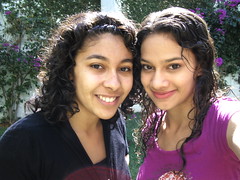 There is so much suffering all around me here. Actually, today was the first time I thought maybe Guatemala is not as ‘broken’ as I thought, but rather I am looking through a magnifying glass at how broken humanity is in general. I remember the night our Guatemalan group visited Guana Chapi. I’ll never forget the overwhelming since of suffering I came away with from there. The three families told their stories in very fluid Spanish-but I kept seeing this girl. She worked for the restaurant, but was constantly watching our group. My heart just kept going out to her for some reason. Finally I asked her where she was from and it was as if I gave her mouth a key and turned it for her. She told me how she was from El Salvador and that she came illegally across the border to live with her uncle. She left her entire family and country because of economic reasons. I think she saw everyone telling his or her stories and after feeling so much suffering herself, just wanted someone to ask her about her story. I was blessed with her openness, but I was again burdened with the suffering of many that I cannot begin to understand. Yet somehow, still people come to America. How can I be a light to people here? Again, I feel as if there is a call on my life to-hah-break down walls, to discover stories and give them a voice. I have this longing for this girl to know Jesus-and to learn to know Lisa. Perhaps she could connect with her well and begin to find a community. Perhaps she would find the hope of Jesus, or the reassurance of faith.
There is so much suffering all around me here. Actually, today was the first time I thought maybe Guatemala is not as ‘broken’ as I thought, but rather I am looking through a magnifying glass at how broken humanity is in general. I remember the night our Guatemalan group visited Guana Chapi. I’ll never forget the overwhelming since of suffering I came away with from there. The three families told their stories in very fluid Spanish-but I kept seeing this girl. She worked for the restaurant, but was constantly watching our group. My heart just kept going out to her for some reason. Finally I asked her where she was from and it was as if I gave her mouth a key and turned it for her. She told me how she was from El Salvador and that she came illegally across the border to live with her uncle. She left her entire family and country because of economic reasons. I think she saw everyone telling his or her stories and after feeling so much suffering herself, just wanted someone to ask her about her story. I was blessed with her openness, but I was again burdened with the suffering of many that I cannot begin to understand. Yet somehow, still people come to America. How can I be a light to people here? Again, I feel as if there is a call on my life to-hah-break down walls, to discover stories and give them a voice. I have this longing for this girl to know Jesus-and to learn to know Lisa. Perhaps she could connect with her well and begin to find a community. Perhaps she would find the hope of Jesus, or the reassurance of faith.
So many immigrating to America-and why? Vernon and Jim talked about the colonization of Central America and how as a result, now Central America has problems with connecting some communities because of the way roads were built towards the ports and not between cities. Countries in Central America definitely have a hard position to try and become economically stable countries. They have become stuck in cycles of debt, taking loans, increasing industry, but hurting the poor guy-who then, in desperation causes deforestation, hurting the environment and possibly causing mudslides, which ends up killing people and destroying efforts to increase the economy in the country.
Are we “destined”-I hate that word-to be a victim of our homeland? If someone is born in Guatemala, are they sucked into the suffering cycles we heard about in our classes and from the immigrant families? 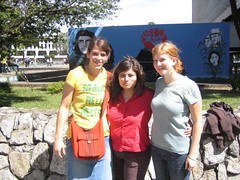 If born in America, do we automatically have the freedoms we are allowed and seek after the ‘American Dream?’ Similarly, faith. If a person is born in a Christian home, are they going to become a Christian more likely than the child born to Buddhists? How do we handle the cards dealt us, or the plans God has for us? I am blessed, I realize that. How do I be thankful and not feel guilty? Goodness. Maybe thankfulness and gratitude is the seed of passion, which love waters until a blooming passion springs forth with new life.
If born in America, do we automatically have the freedoms we are allowed and seek after the ‘American Dream?’ Similarly, faith. If a person is born in a Christian home, are they going to become a Christian more likely than the child born to Buddhists? How do we handle the cards dealt us, or the plans God has for us? I am blessed, I realize that. How do I be thankful and not feel guilty? Goodness. Maybe thankfulness and gratitude is the seed of passion, which love waters until a blooming passion springs forth with new life.
-Monika Burkholder
In some ways it’s hard to believe that only two weeks have passed on our cross-cultural time. Our time has been filled with much learning through lectures, field trips, time with our host families and being in Guatemala City. This last week was full of many adventures that were invaluable experiences. On Tuesday our group was privileged to hear from Hector Castañeda. He told our group about the last 70 years of history in Guatemala. His insights into the culture and consequences of the history shone through his words and personal experience. Guatemala has suffered much and continues to deal with the consequences even now. His words evoked many questions from our group and we could have talked with him for much longer.
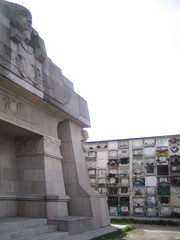 Wednesday afternoon was our free afternoon for the week and the group was kept busy with a short meeting in the early afternoon followed by time doing homework, quick trips across the street to Novicentro and basking in the warmth of the sun. On Thursday afternoon our group piled into a bus to visit the Cemetery in Zone Three where we split into small groups. The cemetery is split into small roads with endless lines of tombs. For the rich they build large tombs and they are often adorned with the riches of the deceased and fresh flowers left by their loved ones. For those who cannot afford these tombs there are large walls for the mass burials. Each grave is marked with a plaque giving the name and dates of birth and death. After our small group scavenger hunts we met back as a group and visited five significant memorials within the cemetery as a way of discussing the history of Guatemala.
Wednesday afternoon was our free afternoon for the week and the group was kept busy with a short meeting in the early afternoon followed by time doing homework, quick trips across the street to Novicentro and basking in the warmth of the sun. On Thursday afternoon our group piled into a bus to visit the Cemetery in Zone Three where we split into small groups. The cemetery is split into small roads with endless lines of tombs. For the rich they build large tombs and they are often adorned with the riches of the deceased and fresh flowers left by their loved ones. For those who cannot afford these tombs there are large walls for the mass burials. Each grave is marked with a plaque giving the name and dates of birth and death. After our small group scavenger hunts we met back as a group and visited five significant memorials within the cemetery as a way of discussing the history of Guatemala.
After our learning in the cemetery we walked to the back of the cemetery, which overlooks the city dump. I don’t think I was quite prepared for the vultures, smells, and overwhelming amount of stuff that was in the dump. SO many people work in the dump to make their livings. Our group watched a movie on Friday afternoon about the people who work there. For them, it is their survival. They don’t want the dump to close because that would mean they would lose their jobs. The implications of all the issues surrounding the dump amaze and sadden me.
On Friday our group met in the afternoon for debriefing. We discussed some of the issues we were faced with this week and ended with a time of worship together. As our voices lifted together in song to sing ¨Juntos Como Hermanos¨ and a praise and worship song we were joined together.
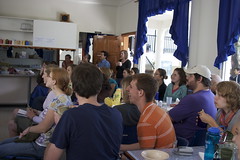 Tuesday, the 20th we gathered in the cafeteria at CASAS during our break from Spanish classes to watch the inauguration of President Obama. Occasionally the live streaming would break up, but we did get to see him sworn in and heard all of his speech. There were Guatemalans gathered with us watching as well. Even in Guatemala this event was much anticipated and brought hope. Our group has grown immensely through our short time here and I look forward to seeing how we continue to grow together.
Tuesday, the 20th we gathered in the cafeteria at CASAS during our break from Spanish classes to watch the inauguration of President Obama. Occasionally the live streaming would break up, but we did get to see him sworn in and heard all of his speech. There were Guatemalans gathered with us watching as well. Even in Guatemala this event was much anticipated and brought hope. Our group has grown immensely through our short time here and I look forward to seeing how we continue to grow together.
-Peyton Erb
